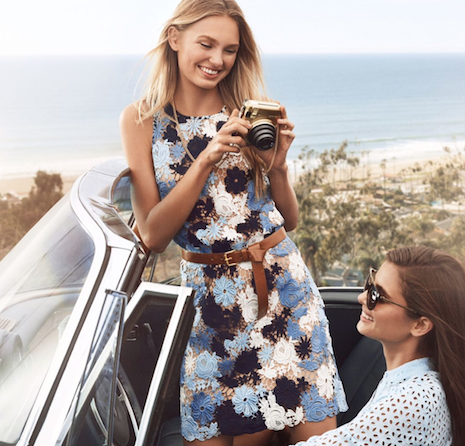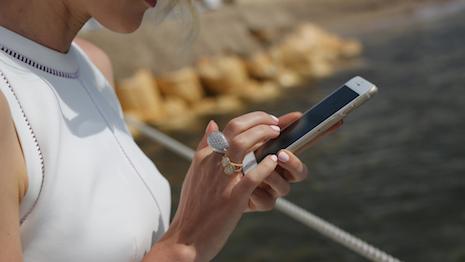While high-end brands have been slower than mass players at adopting digital advertising, luxury marketers are allocating more of their budgets towards online media.
According to Zenith’s fourth annual “Luxury Advertising Expenditure Forecasts” report, a third of luxury brands’ advertising spend this year will be put into digital channels. Luxury brands’ total ad expenditures are poised to grow slightly this year, driven primarily by digital spend.
"Luxury brands have been understandably cautious of digital advertising," said Jonathan Barnard, head of forecasting/ director of global intelligence at Zenith, London.
"Digital ad formats have often been interruptive and, in some cases, of lower quality, appearing alongside content that did little to support premium brand values," he said. "Brands are now spending more because the digital experience has changed.
"Ad formats are more immersive, and brands can use advanced forms of programmatic to ensure that their ads appear alongside high-quality content that supports their values. New technology allows brands to personalize their creative at scale, tailoring their messages to provide individuals with unique and exclusive experiences."
Zenith’s report looks at luxury automobiles, fragrances and beauty, fashion and accessories, watches and jewelry and hospitality. The research covers 23 global markets including Brazil, China, France, Germany, Italy, Japan, Russia, South Africa, South Korea, the United States and the United Kingdom.
Digital divide
Luxury advertising spend is projected to rise 2.4 percent in 2018. This figure is lower than the overall advertising growth rate of 4.2 percent for next year.
Zenith attributes this partly to challenges facing luxury marketers. The industry is being forced to adapt to a younger clientele that favors experiences over things.
"The luxury industry is struggling to adjust to shifts in generational priorities, such as younger consumers’ preferences for experiences over material goods," Mr. Barnard said. "The luxury sector has grown more slowly than the economy as whole in recent years, and that has naturally fed through to advertising expenditure.
"But digital transformation is creating new opportunities for luxury brand growth, which should stimulate spend in the near future," he said. "It’s also true that we are seeing luxury brands move some budget into owned content, distributed on social channels, in order to create more personalized experiences with younger audiences."

Luxury brands have to adjust to millennials' desires for experiences over things. Image credit: Michael Kors
Luxury has typically relied heavily on print, but readership of magazines and physical publications is declining.
The report separates high luxury categories from broad luxury sectors, including products such as jewelry and fashion in the former and placing hospitality, automotive and beauty in the latter group.
High luxury labels are more apt than broad luxury brands to turn to print. These brands spent 57 percent of their overall ad budgets on magazines and other print media in 2017.
Zenith expects this portion of ad spend to decline to 55 percent in 2018.
Meanwhile, broad luxury categories allocate 41 percent of their budgets to television, with the mass media channel attracting the majority of their spend.
Across all luxury brands, digital media is gaining ground in media buying. Whereas digital channels represented 30 percent of marketers’ total advertising budgets in 2017, this year digital will account for 33 percent of total ad spend.
This is behind the advertising industry average of 42 percent digital marketing.
Hospitality companies, however, are leading the way in luxury for digital advertising adoption. As of 2018, half of the budgets for high-end hotels, clubs and restaurants will be spent online.
While hospitality brands trade in primarily physical experiences, the category is seeing a lot of online bookings, with the path to purchase often completed digitally. Comparatively, consumers still rely heavily on bricks-and-mortar channels to buy tactile luxury goods.
Following hospitality, automotive marques have the second highest portion of their budgets allocated toward digital placements, at 39 percent.
Digital media spend in luxury is expected to grow to 35 percent of marketers’ budgets by 2019, with an additional $886 million spent on online media.

Piccadilly Lights. Image credit: Landsec
Television and cinema advertising will also grow by 2019. In contrast, print media and outdoor advertising will see a decrease of $305 million by 2019.
"It’s inevitable that luxury print advertising will fall over the next few years, but that’s not necessarily true for luxury publishers," Mr. Barnard said. "They are well positioned to provide the ideal online environment for luxury advertising with their digital brand extensions, and they have the potential to unlock even greater value by partnering with luxury brands to create high-quality branded content and wider branded experiences, such as events and retail pop-ups."
Priority markets
The United States was the top market for luxury ad spend last year, with China coming in second. Together, they represented 61 percent of these brands' total advertising dollars in 2017.
Reflecting Chinese consumers’ digital mindset, luxury marketers spend more on online advertising in China than the average. In 2017, digital made up half of luxury ad spend, and Zenith predicts this will grow to 61 percent by 2019.
Likely due to Chinese consumers' eagerness to adapt to digital, new data from the Global Ecommerce Leaders Forum shows that leading retailers are focusing on China as they modify their online strategies.
While online retail platforms such as Tmall are highly influential on the Chinese shopper, brands are seeking more value and deeper relationships. Brands from the United States are using these platforms to gain a better stronghold on China (see story).
Globally, smartphones and social media are becoming such a prolific force in consumers’ lives that even luxury brands are gravitating away from highly polished print ads to interactive mobile marketing.
Luxury marketers are now being forced to turn to the digital handheld-screen in an effort to connect to their audiences' shifting attention. Those that are jumping in full force with innovative and bespoke ideas are seeing results, but many are lagging behind, hoping to let their legacy and heritage carry them forward (see story).
"This is an ongoing process, not something specific to this year, but luxury is above all an experience," Zenith's Mr. Barnard said. "Luxury brands should focus on improving their consumer experience before, during and after the purchase.
"Traditionally, luxury brands have focused on in-store to create very personalized experiences," he said. "We are now starting to be able to replicate this personalized experience that is true to the craft and value of luxury brands, through digital.
"Through advances in data and technology, we are now able to create personalized experiences across multiple platforms. ‘Cross platform storytelling’ is a real opportunity for luxury brands."
{"ct":"d42Atw\/VZYDnco44Qf2FAUoCVeBqv4nbJ1gp4Mhmp9KwuLV2I6PYmms0v3fu6t8Ou\/cFqZtQkoo3yzvyHnaFAndUu3G9WMIeLPH8U1hmGLNSEZTHdue6Ovox3HHgK6h8EhLDo2J\/vq7t56FenxKN7D7Fa9FyIqAmbWkgevu2L7SIASFFUDCk0XxGAPnkpwc0tfl6THlwQY2bM2mjWL\/7YR8lAMw84gPHMNUIWBsmUuHQx1rD2m\/3AAXS\/7b6ICnTGRbXJcSFqd7ixQWmp\/wQ1HczA4M3SFRhL7+BqwZ8FEz46fRMyWo26fZwZ2NOzZYltdHJYiI7y2qHTecfIjhRzBNrBx+rjmt9cu\/yK0beQk9q8Asxa3DySTuC35meJw9QBRGUHKSap27cjbGwi4hIPZoqur94mVdIOxfHkxPRDIguVFUrSFISJVOx5E+UjJOxbbljwVkcvNVWESxt7Cp6F4+t+TPFsMuhc3bMN81tgA6144FPOfqPmopZwdEiwo49dInxnEnDQBKU4Mk\/nyP70XT4WbpymsKxfxto6LUi8FHbG9cuDAm7MzZZ7Rfx3GJM\/nX9etRYvkpn2loq0zFmXnw0Z1A56HAjDQBKJhxc5b9JuWyaW9GBopdUMc+GVvqBNjnbosLfoVIs9406eKcC4j3ZjozreM3eAVrPONo5Q0cy2FZ\/cwpyQlJqMXlzsf6LOgsc3OLxwqYfEmZrwUGnpNFsPUCNPyZ2wSjwpj7bjpFHuxLowvjSjV5XU\/NghRlruzXHS31kl7H1MesZjnE65JemSP5ZzEnKzoe8W\/W2\/55fNBhY881\/jpxmtez35GZ\/UUtyimfYLaSehFF4jVuwmYFkzDA2D65ytYT4h7CEMXRYIV3BAKwAgOH200fVHIqwfmOaU4lnPRqMapgDoYotJptQ6zlYSUKcOa+nTZO0JXoqK+8l38IQto+AtFaauEq17ETE9kmVLHYW1uWlOd\/gs+5yESuoZvx9UiZsfu0qJAre6B3aClH26irrDw0OLZ1ZUrFEVFcUDe160587SyzxS1KJCVcHpcqE0t75VkAS9EeS9UhaBYIS+grpbnoce+YQWIQdC003kjXe9CSJ\/\/CTJXZ+YnlLgDKtylJJI2luBBgJT8U5ZIGD5HntvpUU8mlfkCUikI\/gIGHfu1RkU1QHp+F0Moh8qfQ8gq8c7JCJ09AhbFYciVRC31DuDjKHd+c+gIRXxgr+13FcO5XLIompvebDu0rCzcAeh3Fx+AA7dQnUjutJm+diKZVAyfmd9ErOuyM0cOURmRJ9PhtoZcebZVwkndqqA\/pq2FwhQbXZAy22uHVuEO\/1\/xRJpa70R\/kzPFN\/GKzp9uoea8yKvOEV89LVehcRh1KHrkBHDVvhfuo1taF9JjJh83nexXv2Mw3\/RGwBzMBDB4D9IBMiwDQaWjELOBoR0zI3JUMBRhZjdiYnjUUtNtaNJ9ALUUZ9gnq7k1kdMJsbAH7XC\/YgjscSX+fwYhc+8oJG\/ctCKz3jMZepdUaxv0wUGcZ1XgIXMPW2ohjBdmVxiD2uowO2m1DaDtShHcKi+IrioddyX9ntizkX8jRLG277ASD8MUMXsUBl2LA1ykW7auv6h1zlb80DjG87+u4l5QHp1pwZBRjPasl8arnt+hXDRjXxmB08\/ZoCVKwdhfbFGCAVE3DamL5hUc9uUw0mbtsSN5Q+Mmpu\/41AG1De4n7JU3aFHBAN7+koO5x2722FhTzMOG\/hEm9YmgbiMEjK1Iq6T97iqQs\/l3c+iJrkellFijX74BwotPmrwdKWs+FIzzhrOnNBahwh1zzS0osmrPcatAzgVRA8HrB\/4ImZ9MNmNUIHuUBKPwn13kWkbs4NEpPDua69In56V58FBD\/D8kDzRxxUyhVHxuYWgQqCU6rLKQaxC5JlkQyQuyMUu3KD6A8nDFxMUh4FoLL1k+\/k+8JH0koOxnBuU7PQE4O8gEg\/UpwAEpH6qJhI8Ztgwt641lCC\/DGWZbV045FB9X1FU+8k2Mu+mQ7dzrrNXXvkx1fcGtI8wJ8ugwi092Y8UhXbsBkt3hzDFdGbuQx\/+xQ8LjHK8t0BuA3kdYHxfJHx7MMg\/m\/0d0LlCNoTIpokngea2HetKiWrPhWxC08F6aq2w6TpR3Mjr1\/5DcfZCn7yY\/kCZci5Sj9\/hE97BjP9rXLIX2q5Vm+T5HozJ2fC1sXHFcutNIGWAIac9EInXXMsWCw\/yCn6XVOq8K1NFQ6S5emQSbTnbfHLTJ6QQZqCBQ5ICCzXllHY9lFtdAS9HRYNEVEdeh8g\/DepfhpaeLMl+FtLvLcudDmUQsJ+24NCiSoyIQXwZoHrZHyJyAN+\/ldVV8jWbD9ukRZMd9ZkWELUWydt0\/L\/RdkiE1yANWYFGZ2yqrMhXONQ8o2FIcKswRccxlirdHXzFBe2hi6s17LdihM36ZwpdHYqPqBn9e1fMIt5s0EeMwf\/m2KLUuLIADtHKcsRupuiPbD617bDvfCc4+\/p4AzE3ZNk5ft2Qjyfph1bfUBx3yFIFpIIWCBmzL15q9YLHizCw6UljYexS0zTBXCWpkrwyzpLCfgmBTR3\/d0GAU4Mve6JTmoagCvOBmuGAfDaw3pKWcFpBgm0w13pe728M2vw6U8ZpylTV4NUTyfQkyJZoXiAWaZCqAkkiEHqh49AlnXivOFXyplOCUYKUnBkCG3XUCWxjuvgRJPOaKj557RJbPpI9o\/WY6LPE8wEKLlR8L4tpVYeJ76Ea9Opt7ok8piaa3+DJh2eU64+xqc\/\/obZnm8xSEILvTyuLYosWbJex3KBIAPLur\/wWs0hoyz6Zb3Fl9T63ESD51P8UuRjUgsTBimEKdyPCycnlpeLBj+eTKP1PD5EWi2VQXE18uqjo3\/k1BK0z\/pNDkiWljOG17eAVCjc6ca0pZVrVmjJE666MbhYZDrLmgd0CK35vEunCMNZGR0mxS2AN5alYxIuVPDeu+GgPvia0nTtHQfFViT1DbSZBGj89Qyg953\/l5cynwIvmDc1gfjmyayZ8m1vVuumCs66HeDgZwnRbGiLfp5oT9K2RMB7G6ClWPkKoRPULN+\/IFtnnESTkPZew6Sj3NHyByXBUbx49KIOKwj6b78A5qs\/xKTzW64c9WNW\/2TvpNzY37CxcxDYN2MtsZ0VlKAVJzqC0rRr6HHbAIAfDwslEA51RVEC31QmRN7XwFE5cHw4LcvtpWPuuv\/mWmExyKgdrtu11FI6u5rA9XhKexQa4o8kHuWNn\/fEUvz3\/n\/JEQ+iHzUUdLu0bs4oBZJKfVQKhRYFOpyTMABLUfDPgP+xRmbLFxaHc\/Vp9j+4zynnlHGBwz\/X4SktNBOFsUo5R2PlMMxdaQkZcyzmlFQ1NT6DEhaX8CkBN9qBzSX5YRTYWIwFvIktFJuaWvYcZhwzddiVa+ffPk23WBJkvEp+aRPEDNNkWJtE9jhGRcH1fC6CQMpUn2q6AymXOIItWWxmr5PmWmvttAUa7lNbqTGmvtS\/DrHStAQoMTzKQ6Ywabjal4K0bTKXI0vKN\/b9C8aa2zRq2LIZC5FVjqce2WzlLb4a6p5jOX4bPLeTb0ZE\/LnEMbieRCi71hXUVQSrk3sA\/J0uGvl1nXZQmilXq52JX7kqp6eqwJZ6l1iRDYLq0gVvX2kOmNUlH23ZhKPR5KOP75pAQzGDASejmIKsmhmOJzm9WWrhYuJf9OdpRUgv0KvEDZR9InrNnGaXzKiXqxYReZxww8ZW6E8d4+Jym2DJgu9gihkqJTOKMf6fuOjHeqkEVN2aFs3+8OkAZ0MIPDCQaSU5cML5a76ALdHewgrS4zLss5vo9fS5atwiTaUGNu3Qwju0SWh2h7WaoFyvNxz3LmvZWYbmvq8OAwyCGIWw8AeRmYkCbP0dF+auHXvzhHvNYjFmumnuJ8rjIpcRCQkgpcrG2YQy3BQCeaNzhj3FYVPYQ6Os7KtbnEkgMLHXqkTT1zD3NDFlJkxm2dOTh9KtK7DaEhgGq02xJTkSZ5CqF9I7lGL8suCzBtZ59mNE\/ZbTREJ+DN62t9q+yyEFZAB\/cH+LjgJhVsAfAkop5t1jayxq6QjZ9QrYGNfpH7YT6qyH0gGYNkl4Pba4SVlIJ3Qq0v+BdXThgODbXrkou8AZLnrHK1Fmx4qb01FrGcgylw2xnZ32sTv8nj19l\/c9bm6cScETTTQ9o3AIhUvcUkWqrpTDXScUCSTAzuijYITiQN91lQBxWM5cvQ6KYMKcM7nEUMu8nPsX9wwDDb32ePmm+BQbxZNP24QeA78aHgPoVNMubE8cQSesjsLX85x5H6427orCyHA+yhDhymJJ7zUSz+1zUlfLPJ2rG2GgmM9wISf40TaVLvrwZ+kuDIum7mr3b+PiyWEv5\/TNFTxN08q2444clfft9xfT9SAIVcMjQqmQVEONRGzqqqbJOno6ZtI2VV1+xo6p+dYGTWUE5U7ERNRLVyaaJzgaO2aBTqBHrngPMcW4K2Pde8Xjj8BvUQPbQTp86A63Ddpe8lw1Fmfu2QrTvXibbSzmKGb3ZH7HBbhu32UQwRQowxBJeXADtDwX5mDbdYYFcnvQEHp70mrpE5iBeQ1\/xiQn2SLe+f+vFfHSJSOkSDGg1Cxxh6eh\/ToN431u42E\/\/K6DCva0H0h\/qMWHkb5Iusq+Xe\/mmUnAOaZtnkYHScd9OvyRbFaWWXtaOWLPtgabuCOihZHIvujnI8X0stHn5+C4cZ4RtYRRENFBAn8TfdsqZKU5DKzBsrQZddjHtRjwl92YOWsCm0Ch7\/7X8oQ2g4WTVIDbsJAROrpNJLtN\/k8h5p2knRXdNPZzXYDthNRxY\/nPTaOqubgLxrqbWhWV24ueMUp1X43LWE+Efju+LcbgtFd8PAG4l6Ed\/Us85yp6z\/Mk4SdjoHyhslcGacrUqMmq5HZE84Mb7+AOtX\/HWKNKyZAwl1d0xYLxal8aZPWAou098TZFZn\/QvtIaFP2c1C1Whg30B8SZ6ZsrKntUUQR+idgzrHz59SX93OTqBTR8Z463ZD+9Gvp15PamhYKfwNW7O1CCnExmvjKcVN9+4NZgHfeT6x5S7WzV1AsLRaezhqhmTfR9TDcLhNbmArpcgnxYanWQeA7dTboWeVhlTnqcw4KjN2aYdPfACYT6li2g0UCtX19zbb4NIFI8osyXofHZYIlef4fqT1N3plvy5FpM3Mo6KkF586WSWekTZpn74rF752X08K9eOvc2GUUTqa3FsxWO9zASAnogpl9NtIx+MiOMEZHrxvMc0QdPUTPyDZGPKF0xW3OJzNH63eNQNCvzKMrcWBJZGuTJj7I\/RtKkXTFvEGMlq0cht77P9ZoQK9E1bt9h0iWx\/pJz3EeOnF1J\/R4nIz3DbrTW26qWmwXg5JJlFSUWNv5HzvJ\/IIG\/unhERNQejtZ\/vGjig2J\/o\/Hb+vM5uLu+OvK5scajWp+X8rlMOPXZ6BAzgt0K2bxyU9n0gWhe53\/XOsOTsTXRJ6BuMLZNb2GPwKWHvCyWVIKO2NFhzG3e9FEW+zzE86ZQHqXc7Sm6uWrOOL6edTHDpDPpQiUz5SWJJHzlzeh4gCV4Ca+mKTzVpq+RnoG9arJHn3nIcLMOhA8bfWAr2hDXi5SVuVE0Sq\/9LtlpwUMBjO1akmc0wzap5Uk\/HTkeL6nio6xbJKZwg9Wiz7j\/faptTOP1Lml+3ioFbD3mPFcG1+ut9EBeRBKj93Acn9id8H3aqfQuNSJvIXLI2dB26QObul+UG7EZoAtuyZyQhYMrCzTzT2YWR1OQgcZxn6HydCM2RH7COLGNZ532hhft6Due\/zKdLk2fSm4bmRikKkNWSR2hxucoqX3dY97cBWxGIrfOIIWdyiTBXxUDY28otHX6f2d0FiBk6iem9T8PBu6TE9pW7TXR2UIe+u6VhtFbSsy1DKzeOuq7feowCz3LzQH+lq+mzuBZ935RYRdrUvvOlH4m3LySI9+aiAZieBr942EOh3yePAOdhO+nhl46xnz9wLjpSYoKCSNNNSWHzpwO7d21CWgM0t6u6tauoTBnQxh9ciXupyaKX2EMWX\/gUxUUgE033LGRJ7iuErsB1Va5rtPb8vd7s1FqxAtCegdQS2KdTukPY+7BHxiIq7Jx6PrOO4RTYmuupSEHB6s6yMjy4RdNGDgsLyEfJoTzpmG1xd5XQfO\/sXXfHRD\/OnA\/f\/z6pLl934ECOXyFC7JCLlDyhPFNtXzX\/2hlZMVy82kuiVBb4gKL\/ljF2\/jxu5FiXgcItxYw\/w+q2I26KnrJfjr6lDDMryttjT1uSfLncX53yU3rbyqSr+kNJXu9KT6xQyQ9zlElD93aUS4AIMb0EqBIf67\/P92j+q3WXoV5koT\/4uVV9\/JV6ftEC1f5DzAIY0NI4Zytpi0TsSrILytK5EThnW5HlfoCm2hx4ul1q10eQg10M3iwbZamyYI0CsRqsmLMH3ckjGKWe3tHg6orJwCTDR6CycajelV9GrBo99p1Ze7jiGjxMUZNbO+xHlRJBGSAU6CSLdAZhJwXjmsvImQ6ja1vUgdTMMLpUg1q4v4y\/9FGPROA4tlNsBbnJ1XfDhjMRvkGCHmN2JHjti8E5uBWqee1vurKgm7x\/fq8wH2n0Nkxh4Ez3fxZ7BNqQPxvEN2Io\/yQ72L2POcZA595D3wmK6PzSeO+9FZ+iqoSIsubUTZWefP8cq2tfmaftMsJulqRuhFGz2l4VVGzfeTNpNx8PsA465Zh7CDN364qAIrpIR20+2Dzcad3Xu+SNLZkqLtJ1WAQMONXVyclrCUFJTSggSOAdy\/hSTvQ1yEdgvwP+aYa4bSPCWxRy4V13T10k1mz3DKCms74\/bZ6z9LZzuFLLIAW3ndskNcV+WOOJKSD5AiKfNeVo36lr0Nf7HgyoxrQ0NNUl\/C2yIt\/wx+vfLlyIdKO+qaOQoEa9erCWoBLiJX7Yo3aOG6ZgBHfynqL1Rc6utGagLGGA3175xCmO9r4FEN4A2Ll7FJcBL+7\/VIBJKAslrB+zwJ4K4Kku0mfPQMEKhXo8ZlgBxxBMnbiql1NqowxqsvzdOvesKH6qK7sdAspDUTntmdhZZK0Jr17sjs6QW7FJ3E38UOrDZLbAasyAbCRCDWwtNAHzm6jjtp07vyubM7oWzqRnr8Hig5lNve3+3+UyhK9Q3PiTFyc9K4LRn\/9skaQ36hwtG2x5\/SpSntXid2QsYQAxyKNRQgyu\/r\/3I8uV+26Z5AP6N\/qGCySrnw9Ak\/xbA351uLfBZKg1z8HM+0IC\/nC6YiwqR1ZnhsHBNS39PLtZw86r\/o8josVEi56H8ZXcrQEwGoF1Ei76nkeCjl4l6ht+SKxoy0Ey4oHhT6XtQfukLXmRseT5+ShkX1g+NtAC62EUw6p3t7g5X79bqO3Nbbg2puQ2sTBAaSum5iw1bsrlEZ4RP6ISfg1P\/fFl38BxvNsxjPSzEWEmIGwGfvs7MV7s5XSi8DI+wsL4YHRJbKowZ0QD+SDPCANZrBpMEPAMY0wZa2XT3v9aTDH9gX86FK+Henzy42PDrBBxPzLRyWVd5OGkuZbivFtDeJAPn0Mw\/GU2AsYfVb8J\/Q36JT4u423oswTLx\/hiAO7wg+W1FBgQpf3mVxPSSuxb4wlQGArAs35YizOSvhV1jlIWu39YddoP\/qWGEPiaTXPfYgaraPfUKTvSHt9DeJYnrjgtJzXsZvAAIl9hC7l+mzI65G00mmO9MOyZ6mGHucnI2VpJtAj7odUsJ1VE6Ks1J\/vmeSi1aTzjfth4Bhz2GSZTmr3Y3J9O7mfHRAH+08ckdWGSWdl4cn1phx5wwGa2a5saH2YPhkZp\/gqxulC9i6DlQB\/KEYAqRzaZuQGsQOnhNsEsuN7+ZqsC15+e\/TJcJQAVebS3Dk5VQYn4\/Z2PnSZN423uqL0Y\/x4aUijjWXVpy1W6ar0IFoLx0LSAejpT62Of6ilkOtHQP5x09iQ7JPaYXavEePU\/b6ZMpdosXW9IvbZSqAwhEwlYKiIcoCXFrVi6ywDCh5UEUFCT1be9mASSVamzn3Vz7O5rG\/kTEhS7mmmp4MvlHWPhqsc2GiPJHThb4NYRL2Bf8Ir+GDmIKUr4V+qFrOkXl01Hb\/fA96iu9yfNBLwKLoFA06AKmiwqkG7DZx2RLtWsxko0qR7U9QZFsDkiqYq\/CwWa0L+6pt+c\/AZ6uvDDddEU6aht\/CTfQLjoBWPO6LXFMBchf6mb6CUVDNGumy5KLMKRdvAgTiMKVeLBEtyxiULYkW\/rXzSS3vvWMoJ1hpTiYv5vFnlzGYxYdAY5k05\/KU4ESmsxqLSqMVcDTU8\/T2c4nsWlLZ7uCIhn\/+5TIBY7iNxzck\/6acTYILQyz19FqV\/UW+DCrpCdwBjKYR0xR6aqfl+XeX3FDNr2g\/ppw5DAVb0eATE2cQsiXZJIjqqE\/IRaGLzkCVCZUHPS3h4oht9hp7gknt\/5efpYhqR9ui3oFg4l+ZRMtWiRhpT9zva2YPOppIxKmGJeCkjB2rI2d2cvm30cVnYPZVAjdHaO4LmJYpaVofwBPbV7lhfXMerWCJDxLefgsKkfWlqPu8uyYW44A90OewqaJqzG+chP3bVJyPe3MpNGwKWn+uqcs6DRH193OqFwIQdtrB460qqaJtCtDSXTvHv90cqP\/wT+xRGqwJTQavEyKX6Bmy31F9j2wB3bzcp0p2RP16keatUxtHKPkGgXQUZCxB9bQddCLM7NS9BujgDaTWD+mhYj5rhD3zwOwVpu+ISkP2qOBjlXFWyPWQoQ48o\/N0dPAWZXGm6jajmGtzcnUTeckzVAdTgx5QKaWlNK1vUAj8pTvp+H8ig3A9TxST\/N+TpoMd0xmoL52T4V7fksvU0\/01YPuD7ztvXU4g0GpYVZA63R5ny71liIijNGUlOnPEAXTKaDC0LfgqBu8auY669TvWu8Bh6T\/J8f558r3E78BRAXzDSNjUApTTm1gLBQUxYfIHShdC4iZqBOAxd0ziLG06tNATCg\/vx31FowI6bT5r+rpXenFoc3BRCTve\/Hci2EKmipmXiBFHhQO1iESr9C+OzWh0HLGV7cVJWVK5refJZ6AT0aNpdlDYClXwXFUJ5vnZJutNkJ3GJUdIRWn4ETKAuDNoJcN0zP\/p7N2sRCkd9hPlnrVl6zxr0EhacjpMbsbV70Pu59dosVW894BSbqPt2bnKN5oH13d3VWs8wegZeKmN6NgV6WDTnPmR3wnjok84aDC+PtDdw55TxhW1MGAVhy\/1frULClHLeX3mZqkHeDsngfg8G8vknpMY95M6KylWFFoX6jFluFMe7lOVlw0wEBZ60imHPxF1Wkf0eD4FnbE51erQa3n8yfq8q6e5R05o7PSm10uHw+IOfKjAOSv4q2yyqu+pM10eXGZ5yWeuinVBMk\/NdXdfD8Z0Zf5ajaaWQXcwG6vrDKJwl\/aICy4MMb7Ym7zy+oB7A5Wz1Wz5WfBZNxXrnKk3HKKRNSj9UXeP+zi3ijedomv\/sKH9NFv3YcP4db1NxJbAyMWiB7Os7jr5FbGWFhwucCpZtIwm21JrEKgel4TVTPMU+ZQo3AosbKiyk5PSuOKRT3kcA+l7Sv9dtoKdZBUu0ThrqUE9bWSinyi6dm3Q2jylbtz9Eu97T6XzuqNbxn5aJ5h2k\/boxGg9P1bg3ZYSIQMevpKj76wjUiehydi\/rD0pJG+eNo4oSBBIwQr2iTcft69RHNAKziczyAnhlvwhfPGbnyXlVbza+xAtnmwfYbvUQWXSP7qcmAsuGvaMsQukCYhh3w1BGM4zrPXiMjwvvabWYYzUf5A5vikjUMXK6MnK1jbfVlJiWrtb8qN81FdAHM9w5efLU8SCLb5gLYVr9eCYewVt89YFFD5EBpIxPEnVJ1CVfJrjdLIYmczabg\/Z2YwEqWuYc4cwJ+KiCZUAAHsEzuBA3kOEio8rqym9SNU870HtZ36z7jCSbKGhHG+W0DdImLidJf9VFExuEbyBnctyKtfQ77t9K4RJQZRlYidMV70rDWxK0D3PPvANtwuifMwpIgwrQZvHytOXLZFAcmx1Tqkv0oHgdopxAiKgmUrFaoLSOFtGdfm0l18sOnsgefjbmlxA9UM6UitC4WT81DieaLl6hWUP2GKWGEAdWKFwPJ79lvUsDk6OmqEOKkWpJpsHDQX11QjzmaQ5kBzCv+QbzVk40BJkpmBdiWrDdLti8y9RlHproFYalLhdplFL9yW+5LmRgSSyDvGsqIaB9WMN6+Ov\/9bl6pF1AlpGjqCNYZ6GhRvuuAsPgU580jWCAllzVUDolA3vojLgcv83dHQsOvIRdj5e4BIbk73rpYu5hKEEBHZKP0Ko+Jd9fW+t6CLenwdy8jmcLCvlN+vJvF0KQ0AFjbTfaRcGOEhxZwqnz5thQ94Uj2Wd4B5jxWqFDREH3ZDCBxOp7q6ySWVuVBwjfwl8WzDire7lTvRdzH5W2UGvnZSgobrgE0kWV5Th7pAZXNgVVWgWbXpmy2Lve1ZQ6FaHuo9R\/OeH7v1RJMbcM2bmqf8TD6\/oznpydafHW4sjaZj0r48sfNmsa21SG06U2dor9JmKJyABqMo3m\/Kpui4s2znU4zy6hJArt+fOYXTO7xViD9RsgeazNYHahqLxsa+xF4PvgAxxdBV30ETF\/0xX8EuAzIyaMQyNDtTuNfuoliBCmBen61qwq0naX6KzipOoo26\/hHkajHaqAKfymi7gsmq1br9OwPcIQH9F8G+45d\/BbMdnU7PG5Yzav855td1UWOqzyi4hdzvELCHzvjOlPTKCIayb7kdyG0fFoi9utbbk+kNlFy\/AMwQtxQ9mfn2tUVGfM+Tt6sQgoc0H9XCLMKr+XPrXisiAQ2s69dooGEYegxuQQI4MVDAd0McckN8\/gBMVVEUd9F3tvMd1mplqEzRdt5agHaNVVsdeooQgNMn36vmMHyzh\/DXqE5dE4sOtZkrR9dpG5i61bNw4EXBHG9b3LfgtlDWh+v\/sYynkAXgWdLxYKpvVovV8S1F0PyE58aFv9rGnVpKhF7C\/D3KYoZUQlIP3zN3HPj5\/Twl5QKyEftOIz8jXFbs9dgyCuWj5ETwPRMa3o\/6ctP5rVVuQlH+24ZZBwLv9FFs\/IANU1ooC30jAnRZrzX69vy3OzYt5yZpvutKLLleDYjOxSinYQdUaPhZh6LHjHia6kLTN7v7Wxs6FnvL71l9bmHd4F2Axbne3PwqiT0DeO3tg8by7qy434k6tJtwrbdKfHMSzgZ7wX\/bh8AIZNMc6YFbCBqRtMc6kcxBHSFlosgOkD8UHSwYo3Hjld6tjRvLINxBYmA0\/bvwg1a3hkoPPSPJm1xwRRzZyRV6CZvnaBpeVMTXMTgf1cul2gibltYa2o7XnyoPUmJK7mclpPirS6hM7SGT4aVWgKvjwbd+0palA8jBNpRaoNtXYqW2jvVzsWicM7EKYtzhYP9FpRw5nvFMn2ZSDmekmnzABYLSu+3TH7xI+92qMzuXpZkc1NoEt2lV8jOBSKnYMSNj7DIRndhp8MYHR+yUk4qc0fzr3YhRfP9xHXs+fUnAgFh\/fi2JklMCcPMxQkQ3jK1vcLXtrmHlmqkYDbZvltkX0\/TXHVybZ9dyE6njX1DJvwK4DAf1gHesc0PRE7+4hKSM22UOGeebZf7VohGzvPFg==","iv":"cfeb219fd84854aac991e0fec7ef5eb0","s":"518247b2220b7c8b"}

 A third of luxury advertising budgets go to digital media. Photo credit: Boucheron
A third of luxury advertising budgets go to digital media. Photo credit: Boucheron